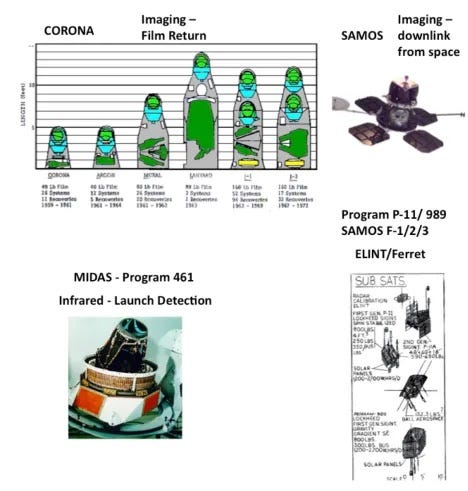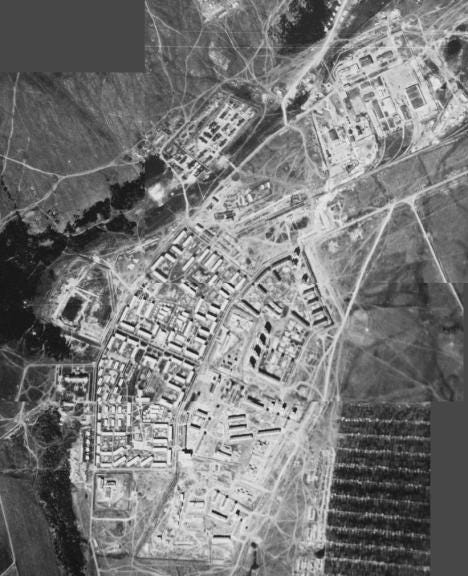This is Part 14 of “The Secret History of Silicon Valley,” Read Part I here, Part II here, Part III here, Part IVa here, Part IVb here, Part V here, Part VIa here, Part VIb here, Part VII here, Part VIII here, Part IX here, Part X here, Part XI here, Part XII here and Part XIII here. See the Secret History bibliography for sources and supplemental reading.
————
The Soviet Union’s detonation of an atomic weapon in 1949 and the start of the Korean War in 1950 fed cold war paranoia in the military and political leadership of the United States. The U.S. intelligence community was determined to find out what was going on inside the Soviet Union. But Soviet secrecy had the country locked down tightly. Desperate for intelligence, the CIA would fly the Lockheed built U-2 spy plane into and over the Soviet Union on 24 missions from 1956-1960 taking photos of its military installations.
But even as the U-2 was beginning its overflights, the U.S. military had concluded that the future of intelligence over the Soviet Union would no longer be with airplanes, but would rely instead on spy satellites orbiting hundreds of miles above in space.
One company in what is today Silicon Valley would build most of them.
Weapons System 117L
In 1956 Lockheed Missiles had just won the contract to build the Polaris Submarine Launched Ballistic Missile (SLBM) for the U.S. Navy in Sunnyvale California, and down in Los Angeles, the U.S. Air Force was on a “crash program” to build land-based Intercontinental Ballistic Missiles (ICBM’s) – the Atlas, Titan and Minuteman.
In 1954, three years before the U.S. or the Soviet Union ever orbited a single satellite, the Air Force asked the RAND corporation to study what satellites could do for the military. Their answer: satellites would enable us to peer over the closed border and inside the Soviet Union. In 1956, the Air Force organization building our ICBMs was assigned to build a family of satellites to spy on the Soviet Union from space. These satellites would be configured to carry out different reconnaissance missions, including photo reconnaissance, infrared missile warning, and Electronic Intelligence.
This military spy satellite program was called Weapons System 117L.
Spies in Sunnyvale
In 1956 the Air Force gave Lockheed Missiles Division in Sunnyvale the contract to build Weapons System 117L.
Over the next two years Weapons System 117L evolved into a large ambitious program with multiple satellites:
The Satellite and Missile Observation System (SAMOS) would take low resolution pictures of the Soviet Union from space and transmit the photos electronically to earth.
Another SAMOS version (called Ferrets) would collect electronic intelligence on Soviet radars and transmit the location and radar details electronically to earth.
The Missile Detection Alarm System (MIDAS) would provide early warning of the launch of Soviet missiles heading to the U.S. by looking for the hot exhaust (the infrared plume) of rocket engines and transmit the location of the launch electronically to earth.
Crisis
In 1957, a year after Lockheed got the contract to start building WS-117L, the Soviet Union tested an ICBM – one that could carry a nuclear warhead to the United States. They quickly followed with the launch of Sputnik, the first earth-orbiting satellite.
These two events jolted the U.S. intelligence agencies into crisis mode. The Soviet Union claimed they could turn out ICBMs like sausages, and the CIA desperately needed to know how many missiles the Soviets really had and where they were.
Not Good Enough
The photo reconnaissance satellite designed for Weapons System-117 would have let the U.S. military see objects larger than 100-feet from space. This 100-foot resolution was sufficient for its original mission – to assess how effective the first wave of nuclear attacks on the Soviet Union had been. This “post-strike bomb damage assessment” would allow targets that had been missed by the nuclear armed SAC bombers to be retargeted for follow-on attacks. Because of the immediacy of the information, it required real-time electronic read-out of film developed on orbit.
The problem was that while 100-foot resolution was good enough to locate craters left in cities from space, it wasn’t sufficient for the new mission; to locate the new Soviet ICBM silos and bombers. In addition, the electronic read-out of film developed on orbit was nowhere near ready; it was too complex for its time and technology.
The CIA and Corona
The CIA convinced the Secretary of Defense that the best bet was to build a separate photo reconnaissance satellite carrying a camera that took pictures from space as it passed over the Soviet Union. Film from the camera would be de-orbited in a capsule that could survive the heat of re-entry from space. A parachute would slow the descent of the capsule, which would be snatched in mid-air over the Pacific Ocean by a recovery plane hooking its parachute. The idea was that this film-based spy satellite would be a short-term project until the Lockheed electronic readout version was in better shape.
This Project was code-named Corona.
The Flamingo Motel
In March 1958 a few unassuming guests checked into the Flamingo Motel in San Mateo, California, near the San Francisco airport. The CIA, and their primary contractors Lockheed, Kodak, Fairchild and GE, met to hash out their roles and the schedule. The CIA was the customer. Lockheed would integrate and assemble the satellites, Itek (which replaced Fairchild) would provide the camera, Kodak the film, and GE would provide the recovery system that would bring the exposed film through the fiery re-entry back to earth.
After the meeting, the Lockheed manager for Corona rented his own hotel room in Rickey’s Hyatt House in Palo Alto to start to plan the program. He needed to find a factory, separate from the already secret Polaris factory in Sunnyvale. He found an unused facility at the Hiller Helicopter factory on Willow Road in East Palo Alto which became the Lockheed “Advanced Projects” facility.
Watch the video here for more.
Deception
To hide the fact that we were launching high-resolution photo reconnaissance satellites over the Soviet Union, the CIA had the Air Force publically cancel the SAMOS photo reconnaissance portion of WS-117L. The program then was resurrected as a “deep black” “compartmentalized” CIA program. When the Corona satellites were launched the CIA used a “cover” story. They called the Corona satellites the “Discoverer” program and claimed it was an experimental program to develop and test satellite subsystems and explore environmental conditions in space. The film recovery capsule was described as a “biomedical capsule” for the recovery of biological specimens sent into space as an early test of how humans would react to manned spaceflight.
Watch the video here for more.
East Palo Alto – Lockheed’s Satellite Factory
The Corona project was run like a startup – a small team, minimum bureaucracy, focussed on a goal and tightly integrated with customer needs. Starting in February 1959, only 12 months after the program began the Air Force launched the first Corona reconnaissance satellite from the military’s secret spaceport on the California coast at Vandenberg Air Force Base. But the first 13 missions were failures. Yet the program was deemed so important to national security the CIA and the Air Force persevered. And when the first images were received they transformed technical intelligence forever. At first, objects as small as 20-35 feet could be seen from space, with later versions improving to be able to see 6 foot objects, over millions of miles of a formally closed country.
Over the life of the program there were 145 Corona launches – 120 were complete or partial successes. During that same decade the Corona program evolved into six different satellite models (the KH-1 thru KH-6) with three different intelligence objectives.
Lockheed turned the Hiller Helicopter plant in East Palo Alto into the control facility for all spy satellites and the Corona spy satellite assembly line – building about one a month and delivering ~145 Corona satellites over the life of the program.
Stanford, Jasons, WS-117L and Corona
In addition to Lockheed, Stanford University also had a hand in Corona. Sidney Drell, then a professor in the Stanford Physics department, was one of the dozen of young scientists who were founding members of the Jason Group (scientists working on national security problems.) His first project was understanding whether a Soviet nuclear burst in space could blind the infrared sensors on the Midas portion of WS-117L. This research got him invited to be part of the President’s Scientific Advisory Council (PSAC). But it was when the CIA asked him to solve some technical problems with the film on the Corona spacecraft that his career became intertwined with photo reconnaissance. His studies convinced the CIA that photo interpreters needed an order of magnitude improvement in resolution, and Corona had been pushed to its limits. In the late 1960’s Drell, as a member of the Land Panel convinced the CIA that the next generation of photo reconnaissance satellites should transmit their images back to earth in real-time, and use CCD’s rather than film.
For his work, Drell, still at Stanford, was recognized as one of the ten founders of National Reconnaissance by the NRO.
Corona Firsts
While Corona had a number of technological breakthroughs, including the first photoreconnaissance satellite, the first recovery of an object from space, etc. it was Corona imagery in 1961 that told the intelligence community and the new Kennedy administration that the “missile gap” (the supposed Soviet lead in ICBMs) was illusory. By fall of 1961 Soviet Union had a total of six deployed ICBMs – we had ten times as many. In truth, it was the U.S. that had the lead in missiles.
Corona was just the beginning. Overhead reconnaissance would become an integral part of the U.S. intelligence community. Hidden in plain sight, Lockheed and the U.S. intelligence community were just getting started in Silicon Valley.
Next – Agena, Midas, Ferrets and the NRO in Part XV of the Secret History of Silicon Valley.





